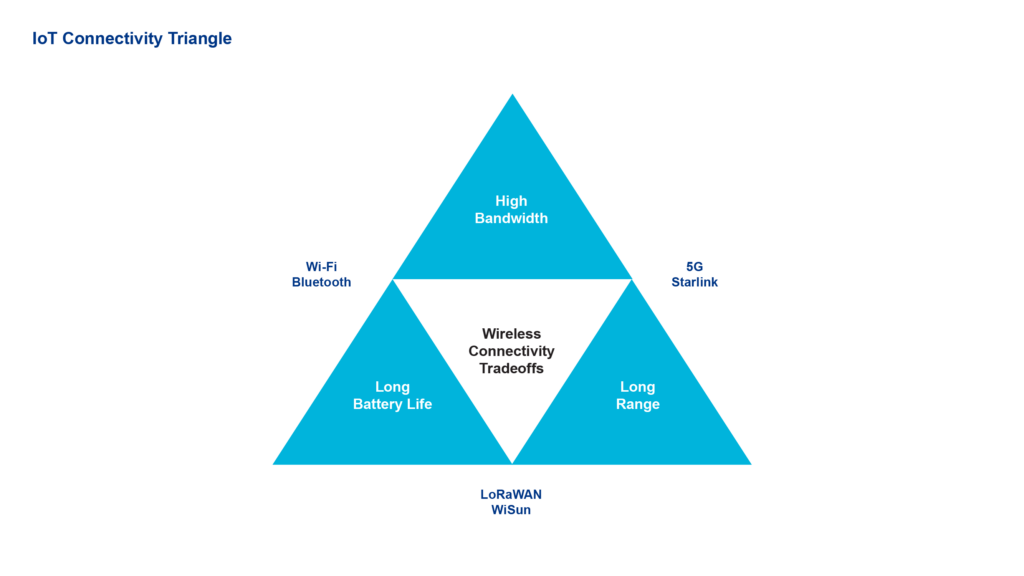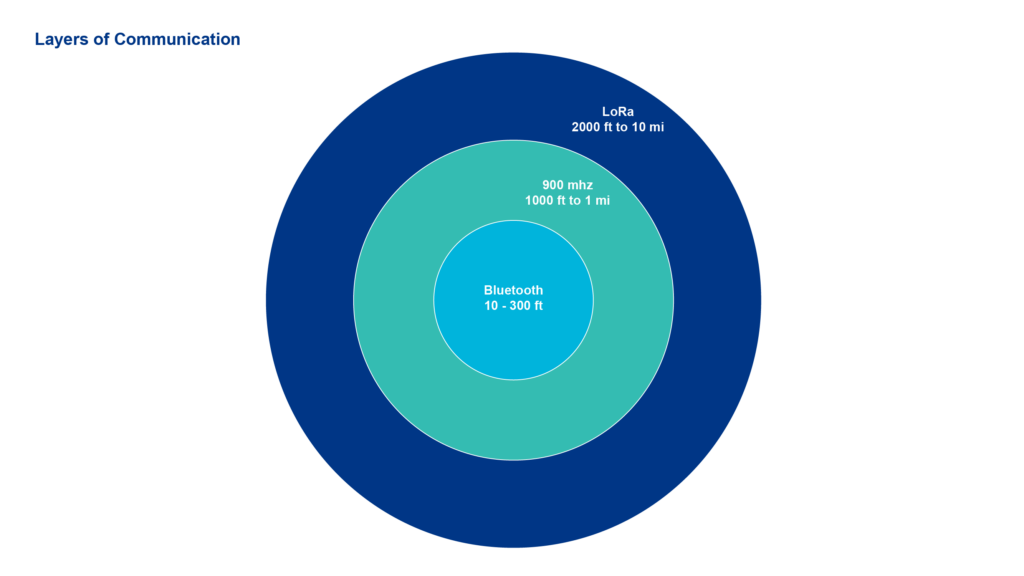I often daydream about how to improve IoT connectivity. Early in my career, back when IoT was called M2M, you really had to have low expectations. IoT connectivity was expensive and without standards. Early developers in the IoT arena had to develop their own wireless protocols, security and encryption models, along with gateways and device management software. Due to this high complexity, only projects that could justify expensive hardware and software were successful.
IoT Connectivity Triangle
A decade later, we now see the emergence of some great IoT connectivity options, but each method of wireless communication comes with its own tradeoffs. I built the following graphic to help simplify the basic tradeoffs you face when selecting an IoT wireless communication protocol.

It’s important to understand that you can only have 2 of the 3 corners of the triangle with any single communication method.
For example, Wi-Fi and Bluetooth were not designed for long-range communication, but instead are optimized for bandwidth and battery life. Between long-range and high-bandwidth you see SpaceX’s Starlink. Starlink is able to send gigabits of data over hundreds of miles, but was never optimized for long battery life. The bottom of the triangle, where bandwidth is sacrificed for range and battery life, is where Meshify’s needs are met. We need sensors to send very small amounts of data over long distances and last for many years on a small battery.
Meshify is focused on delivering risk-reducing technology to the insurance industry. We need to predict when a pipe is likely to freeze and break, detect water leaks, mold, and other perils that can be avoided. LoRaWAN, as a result, was a natural fit for us. On 2 AA batteries, a LoRa radio can send a temperature reading every 15 minutes over a distance of a few miles for 5+ years. In addition, the physical radios are inexpensive and easy to program.
The main drawback is that LoRaWAN was mainly contrived to be a carrier technology. It was envisioned that large expensive gateways would be placed on towers throughout cities allowing thousands of IoT devices to easily connect back to the internet. Ubiquitous third party LoRaWAN coverage never fully emerged, forcing us to deploy small gateways at every location. The cost of these gateways is a major hurdle to adoption of our sensors in the insurance space.
To obtain mass adoption, we need all of the features of LoRaWAN, without the cost and headache of deploying gateways.
Ecosystem Provides a Way
In my daydreams, I have imagined a world where every smart TV, IoT camera, or smart thermostat was a gateway in a nationwide IoT network. If the ecosystem combined to make this vision a reality, it would bring a new inflection point to IoT growth. I believe that there are many great IoT applications that can create immense real-world value, but are only possible with hyperscale and unit economics that only this type of network could produce. With this vision clearly on my mind, I received a phone call from a friend explaining to me that Amazon is doing just that.
The new network is called Amazon Sidewalk. Sidewalk is a free, community-based network comprising of Alexa and Ring gateways that allows low cost, low power IoT devices like sensors to connect to the cloud. With support for both LoRa in the 900 MHz band and Bluetooth, Sidewalk is a natural fit for our business. When fully launched, device manufacturers can build IoT capabilities into their products that communicate, using multiple layers of encryption, back to the internet via these Ring and Alexa devices. This communication model is almost like adding cellular connectivity to a device, but at a fraction of the radio and data rate costs, while allowing sensors to transmit for years or more with small batteries.
With traditional technologies, consumers must deploy and maintain connected products. This means installing an app, adding/modifying passwords, and using a combination of button presses to start commissioning them. This creates friction and disincentivizes deployment. Sidewalk eliminates the need for consumers to commission devices thanks to Frustration Free Networking (FFN).

It’s important to note that not every Sidewalk gateway has the LoRa capable radio, but given the extremely long-range of the many millions of devices that do already have this capability, you can begin to imagine how amazing this coverage already is…and it’s growing! In fact, we have yet to find a location in our early testing where we couldn’t connect over LoRa to Sidewalk. Another added bonus is that Sidewalk is a feature that is tightly integrated with AWS IoT Core.
For example, a water leak sensor that periodically reports sensing information is useless if the data is not collected, analyzed and processed to provide the user alerts (e.g., ‘there might a leak near the washing machine’) and the insurance company/utilities with analytics and useful insights on the water sensor data (e.g., ‘the water pipes in the north east area tend to leak when the temperature was below 15 C for two days’). We are able to quickly implement this functionality leveraging Sidewalk’s native integration with AWS IoT and the broad set of AWS tools and services with which we were already familiar.
IoT Fell Short of Promised Growth
Back in 2010, I stood in front of a packed auditorium, pitching Meshify to potential investors at Rice University’s business competition. I presented a chart of the promised growth of IoT. My chart had a consensus market prediction of 50 billion devices deployed by 2020. The industry fell short, delivering an estimated 9.7 billion devices instead.
I believe that Sidewalk will help correct that course, bringing a new inflection point in IoT growth. We doubled down on our integration with Amazon Sidewalk because we see the economic improvements this brings to our customers. Every day, properties are flooding, burning, and taking on other avoidable damage because these IoT applications have been out of reach. We plan on leveraging this network to democratize these risk reducing applications beyond just high-end buildings and into small businesses, towns and neighborhoods. While I can’t be certain what the future holds, it seems to me that Sidewalk will finally open the floodgates and allow IoT applications to be built that could never have been possible before.






